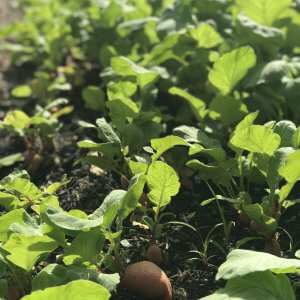When I was fresh out of college, I worked as a guide at a wilderness retreat center. We hosted weekend retreat groups, encouraged participants to compost food waste in our big compost bins, and provided a pamphlet to help them do it correctly when one of the staff wasn’t present.
One hot fall afternoon, I drove to work for my usual cleanup after a weekend group. But as soon as I headed toward the two huge bins behind the kitchen, I knew there was trouble. I could smell it from 60 feet away. I could hear the flies at 20 feet, and as I tried to suppress a gag, I think it was safe to assume the group in question had lost their helpful pamphlet.
The huge compost piles were, to put it mildly, wretchedly malodorous. The group had just chucked everything into the bin indiscriminately — shellfish bits, barbecued meat bones, tinfoil, wrappers, huge mounds of leftover potato salad, and more. Left uncovered in the hot autumn sun, entropy had a field day (and so had the raccoons). The well-balanced compost that I’d left them four days prior had been converted to a stinking mound of maggot-infested mush that confirmed every HOA’s stereotypical conception of compost piles: Smelly garbage pits carelessly built.
Within a week or so, and with much enduring, we calmed the compost pile back to quietly odor-free balance.
Stinky compost is not fun, and if you find yourself faced with a pile of rotting stench rather than a mound of future garden fertility, I hope this article can point you in a sweeter-smelling direction. If I could get that post-barbecue pile back into copacetic equilibrium, so can you. Here’s how to fix stinky compost.
The Nose Knows

A healthy compost pile doesn’t smell — or, rather, it smells good. Balanced compost smells like forest soil. Earthy, leafy, somewhat like the woods after all the leaves have fallen in the fall. It’s dark, crumbly, and most of all, balanced. Not too wet, not too dry, not dominated by any one material.

So when a compost pile goes bad, there’s nothing subtle about the problem. But the type of stink that you detect — though you don’t want to be marinating in the stench — is a blessing in disguise. As nasty as the air around the pile may be, it is silently screaming out its problem. Use your nose to diagnose the type of putrid odor, so that you can set about correcting it. Here’s a guide on how to identify your issue.
Sewage Smell (a Dirty Toilet)
Does the compost give you flashbacks of that horrid gas station toilet you had to use when there were no other exits for the next 100 miles? Is the pile soggy and slimy? Sounds like you’ve got a nitrogen imbalance. Nitrogen is an important element of soil fertility, but you can accumulate too much of it quickly when you’ve added tons of “greens” to your compost pile and not enough “browns.”
Greens, as compost warriors already know, are materials full of moisture and able to rot quickly. Think grass clippings, vegetable and fruit peels and cores, or other food waste. Pile too much of those rich materials together, especially when it’s a moist time of year, and the stink won’t be far behind.
Ammonia Smell (Litter Box)
Your greens-overloaded compost pile can reveal its malaise by releasing an eye-watering ammonia smell. If you’re unfamiliar with using ammonia as a cleaner, and don’t exactly know the smell offhand, it can be described as an unpleasant, distinctly chemical smell with a strong accent of stale urine. Think of the smell in a home with 10 cats and one litter box.
Sulfur Smell (Rotting Eggs)

Let’s say you went out to turn your compost, but as soon as you broke the crust on the top, a reek of rotting eggs assaulted your nasal passages.
The sulfur smell is a result of anaerobic bacteria doing their thing. If you remember your middle school science vocabulary list (alongside the “mitochondrion is the powerhouse of a cell”), you should have a clue that any anerobic activity in the pile is a sign that your compost can’t breathe. It’s too tightly compacted, and the result is the not-so-sweet smell detected at the back of a school bus on bean burrito Monday.
Rotting Meat (Roadkill)
There are many things that should go into a backyard compost pile. There are also many things that should not — as my introductory story shares. While there’s nothing wrong or unnatural with allowing animal products to decompose — dead animals rot away outdoors all the time, after all — the fact is, they stink.
That’s by design, I’m convinced. Many animals are scavengers, filling their role as nature’s garbage crew. They extract energy from the dead bodies of former furry neighbors, ensuring nothing in the forest goes to waste. Scavengers can only do their job if they know where dead stuff is, however, which is where that high-heaven stink is necessary, advertising the free-for-all.
So when it comes to your compost, bones, scraps, oils, fats, and dairy products can be a dicey addition. If you have a traditional compost setup — an open box– it’s unlikely they’ll get the chance to actually rot enough to add nutrition to the pile. They’re far, far more likely to attract opossums, raccoons, and stray dogs before then. And before the nighttime bandits make off with their prizes, your yard might smell like a 1900s abattoir.
Weirdly Sweet
It’s hard to describe, isn’t it? The pile smells sweet … but it’s a bad sweet. This is a common side-effect of adding too many fresh grass clippings to the pile. A case of too many greens strikes again.
Treatment Options
All right, so we’ve got a sick compost pile, and you’re sick of smelling it, which is probably why you’ve looked up this article in the first place. Let’s get into how to get the stink gone and return an olfactory balance to your backyard.
Administer Browns
Most of the problems in this list can be addressed by adding more brown material — dry, slow-to-decompose organic matter such as straw, dry autumn leaves, sawdust from untreated wood, shredded newspaper, or cardboard. If you live in a rural area, finding browns should be a piece of cake. You can probably rake up a pile of last year’s leaves from your land without issue, or grab a bale of straw from the feed store. Add it to the stinky compost, mix it in, and I can almost guarantee your problem will resolve within a few days.
Those in urban and suburban areas, however, probably have issues finding browns. When you have a postage stamp of a backyard, there’s just not enough dead, dry organic material available to compensate for all the greens in the pile.
Thankfully, with a little planning and persistence, you can remedy this easily. Here’s some ideas on how to gather browns.
- In the late fall, gather as many dry, dead, brown leaves as you can. Ask your neighbors for theirs (they may give you “weirdo eyebrows” but won’t mind you cleaning up their yard). Store the browns, tightly packed, in heavy-duty garbage bags, and keep them in a shed or garage for when you need them.
- If you work in an office, consider asking for their shredded paper waste. This is often available in embarrassingly huge amounts. Make sure it’s not shiny (magazine-like) paper — only newsprint or copy paper.
- Even if you don’t drink alcohol, check out your local liquor store and ask for their surplus cardboard boxes. They are guaranteed to have more than you need.
Wherever you find it, having dry material on hand is always a good idea — especially during soggy, rainy springs, when stinky compost problems more commonly rear their head.
Aerate
There are several ways to keep oxygen flowing into the middle of the compost pile, keeping those stinky anerobic bacteria from taking over. Some compost piles can be built with perforated PVC pipes that run through the center (somewhat like a chimney) or through the layers, allowing air to reach inside the pile. Other piles can be layered with branches and sticks to keep things airy. Though that approach may be best for cold composting, rather than hot composting because the sticks make turning the pile awkward and difficult.
Stir, Stir, and Stir Some More
If you’re doing hot composting, stirring is a necessary element of introducing air, mixing the materials, and encouraging rapid bacterial activity. Stirring a stinky compost pile will break up compacted layers and better combine your greens and browns. This should reinvigorate the aerobic bacteria to return to a healthy frenzy.
If you’re doing cold composting — a slower, more hands-off approach — occasional stirring can still help combine the layers of the pile and keep stinks from emerging.
Stop Wasting Food
Compost piles are fabulous ways to redeem garden fertility from peelings, cores, and otherwise inedible bits of produce. If you’re tossing tons of leftovers on the pile, and having to constantly address stinky smells, perhaps the real problem in your house isn’t compost that’s too high in nitrogen, but a kitchen that wastes too much food.
There’s a lot of vegetable material that goes into a compost pile that’s still perfectly good to eat. Carrot tops, beet greens, watermelon rinds, leek greens, and tons of other bits and bobs that are usually relegated to rot are perfectly edible, and in some cases, delicious. I wrote an earlier article on how to reduce food waste, and it’s got tons of useful tips and ideas for those looking to change their habits for the better.
Get Chickens
Instead of feeding racoons or overfeeding your compost pile, why not get some chickens instead? Chickens are excellent at converting food scraps — especially meat scraps — into eggs, meat, and manure-rich bedding. You may find, as I do, that with chickens, there aren’t enough scraps for a compost pile in the first place. The coop is the compost pile.
So, have we helped you defeat the stink? Hopefully, you’ve found what you need to quiet down the olfactory assault of your compost pile, and get your yard back to its sweet-smelling ol’ self. Tell us the story of your smelly battles in the comments below!










































We have high nitrogen soil. It is a sandy clay with a 6.0-8.0 ph.
Our compost pile doesn’t smell but it’s slow as molasses.
What should we add?
We always add leaves in the fall and grass clippings in the spring.
We’ve had issues with animals like rats and mice, since we live in the country, if we add kitchen scraps.
The pile is far from the house but we had an influx of rats last fall/winter. I was catching 2-4 a night!!
I was hoping to add the composted soil to my raised vegetable beds in the Spring.
Should we add lime for the leaves?